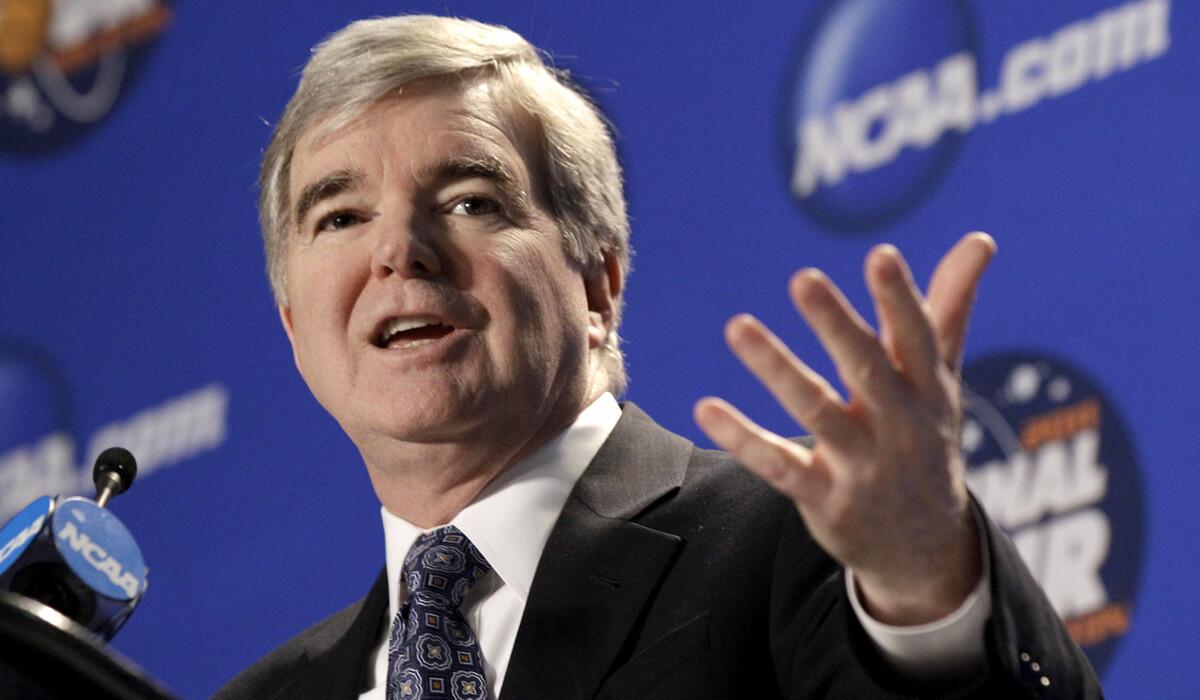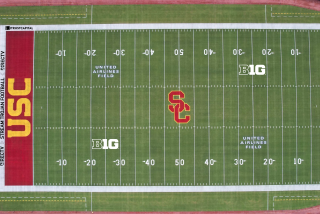In O’Bannon trial, NCAA President Mark Emmert sticks to view of amateurs

NCAA President Mark Emmert was on the witness stand again Friday.
- Share via
In his second day of testimony in the Ed O’Bannon case, NCAA President Mark Emmert on Friday held fast to his views on amateurism as a plaintiffs’ attorney sought to show that purported ideals of collegiate athletics have already been compromised by commercialism and the isolation of student athletes on campus.
Emmert had said Thursday that allowing student athletes to benefit from group licensing rights to their names, images and likeness would “set them apart” from other students -- even if the money were held in trust until they were no longer enrolled -- and undermine the collegiate experience at the heart of association values.
Attorney William Isaacson on Friday rattled off descriptions of several opulent dormitories recently built and allocated partly or entirely to student athletes, indicating that their elite status on campus is a fait accompli.
“Do these types of facilities put athletes in a different class from the normal student body?” he asked.
“It puts them in the same class as half the student body,” Emmert retorted. “Residence halls vary radically from one facility to another. Obviously what you are describing are residence halls that are extremely attractive.”
During his cross-examination, Isaacson placed documents before Emmert aiming to show that even top NCAA officials have discussed both the association’s compromised values and the possibility that it may ultimately be compelled to share name, image and likeness rights with student athletes.
Emmert testified both Thursday and Friday that he became concerned that avatars in video games, while they did not include student athlete names, too closely resembled them and therefore sought to terminate the relationship with Electronic Arts.
He also testified that he objected to the sale of merchandise on the NCAA website that passed users through to institutional sites that were selling numbered student athlete jerseys. Though the jerseys did not bear the athlete’s name, a search by name nevertheless pulled up the appropriate jersey.
Under prodding, however, Emmert conceded Friday that he did not take action to ensure that the member institutions end the practice on their respective websites, saying he did not know whether or not it constituted a violation of NCAA rules.
The class-action antitrust suit was filed five years ago on behalf of former and current Division I men’s basketball and football players, who are seeking an injunction against the NCAA that would effectively allow them to profit from the use of their names, images and likenesses in television broadcasts, rebroadcasts, video games and more.
O’Bannon, the former UCLA basketball star, is the lead plaintiff.
By agreeing on a blanket prohibition on commercial benefit to student athletes, the case alleges, the NCAA and its member colleges and conferences engage in price-fixing and refusal to deal in violation of the Sherman Act.
Other emails from top NCAA officials that Isaacson highlighted included one that noted that the video game situation “really does allow for the maximum commercial exploitation of the student athlete” and that if the practice were to continue it “won’t be long before we have to give them a piece of the profits.” Another said the avatars’ similarity to players went “beyond the plausible deniability” of selling a jersey with a player’s number but no name on the back.
Emmert said he had never heard that term used in association with the practice of selling numbered jerseys affiliated with specific players.
Isaacson also introduced into evidence a staff training document adorned with a stop sign that noted: “The law may also be on the student athlete side” where the right of publicity to name, image and likeness is concerned. Emmert said he had never seen it but conceded that the warning was logical.
The NCAA maintains that student athletes have such a publicity right only with regard to promotion of products -- a practice that NCAA rules disallow -- and to promotion of championship games, which they sign away in waivers. The NCAA claims no such rights exist with regard to live broadcasts. Plaintiffs disagree and say the lucrative telecast agreements center on the use of those names, images and likenesses, whether or not such rights are explicitly articulated in the telecast contracts.
Isaacson on Friday also turned to the concept of competitive balance, which the NCAA maintains would be disturbed if some colleges or conferences agreed to offer student athletes compensation for their publicity rights and others did not. He pointed to documents that indicated that NCAA officials are already wrestling with a distortion in such balance, with higher-resourced schools tending to dominate.
Isaacson pressed: “This says competitive balance seems to have no rational connection to the principal of amateurism. You’ve had those conversations, haven’t you?”
Answered Emmert: “No, I’ve never had those conversations.”
NCAA lead counsel Glenn Pomerantz, on a re-direct examination, sought to put the documents in perspective, saying that just because certain executives believed that certain rule changes would be wise or likely, that didn’t mean the membership would ever vote to approve them.
“Correct?” he asked.
“Correct,” Emmert answered.
Testimony in U.S. District Judge Claudia Wilken’s courtoom continued Friday with Big Ten Conference Commissioner Jim Delany. Other conference officials are expected to take the stand next week, the final week of trial. Wilken is not expected to rule from the bench and whatever she ultimately concludes will almost certainly be appealed.
More to Read
Go beyond the scoreboard
Get the latest on L.A.'s teams in the daily Sports Report newsletter.
You may occasionally receive promotional content from the Los Angeles Times.











